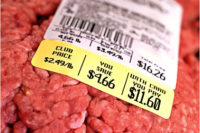Weighing, labeling in line with 'the law'
Weighing and labeling systems help processors ensure products comply with regulatory requirements..

 As the popularity of case-ready products grows, so does the use of systems that weigh and label case-ready primary packages. However, these integrated systems also may be positioned after cartoners or case-packers to weigh and label secondary and distribution packaging.
As the popularity of case-ready products grows, so does the use of systems that weigh and label case-ready primary packages. However, these integrated systems also may be positioned after cartoners or case-packers to weigh and label secondary and distribution packaging.
Weigh-label systems help comply with labeling regulations, ensure package weight matches labeled weight, control giveaway and can apply the serialized codes needed for product traceability. Either catch (variable) or fixed-weight items can be handled.
Hardware choices include standalone or networked; manual, semiautomatic or automatic; and intermittent or continuous motion. Timing is critical to ensure weighing and labeling is synced as product travels through the system, particularly in situations where incoming packages/products do not arrive at a steady rate or vary in size.
Virtually all systems destined for use on meat, pork, poultry or seafood packaging lines feature stainless-steel construction, and many are washdown compatible. In addition to the scale, printer and label applicator, weigh-label systems frequently include integrated barcode scanners to identify incoming product or verify the quality of the freshly printed barcodes. Inspection systems and sorting and reject mechanisms also may be included. Designs are often modular and should be scalable and flexible enough to seamlessly address changes in products, packages, labels or line speeds.
Software governs the systems’ functionality, and network connectivity is essential to enable communication with up- and downstream systems. Networkability allows download of product specifications, label formats and production order details and upload of performance statistics and inventory data to plant- and enterprise-level systems. It also facilitates remote monitoring, troubleshooting and repair.
Operator interfaces are increasingly user-friendly and generally take the form of color touchscreens — a trend for several years now with packaging machines of all types. Most controllers store label data and formats in memory, and many offer label-editing capability, password protection and choice of language.
Throughput ranges from about 40 to 120 per minute, but faster speeds are possible by adding one or more printer/label applicators. Speed is influenced not only by the automation level of the equipment, but also by package size, weight, label size, printing speed, controller processing power and the amount of variable data being printed. In addition to weight, variable information may involve price; country of origin; production, sell- or use-by dates; lot code; serialized code; and product information like ingredient lists and Nutrition Facts boxes.
Printers are typically based on direct thermal or thermal-transfer technology and handle rolls of labels measuring less than 6 inches wide. Resolution of 300 dots per inch (12 dots per millimeter) reproduces highly readable alphanumerics and scan-able barcodes as well as graphics and logos. Many printers used in weigh-label applications operate at a top speed of 12 inches per second, sufficient for a wide variety of applications. However, if faster speeds are needed, a 16-inch-per-second printer can be specified.
Scale choices offer a similar variety and address almost any pack weight. Some common weight ranges include 1-15 pounds, 15-30 pounds and 30-60 pounds. Scale accuracy ensures actual weight and labeled weight meet the requirements of federal, state and local weights and measures laws.
| Weighing/Labeling System Considerations |
|
Looking for a reprint of this article?
From high-res PDFs to custom plaques, order your copy today!






